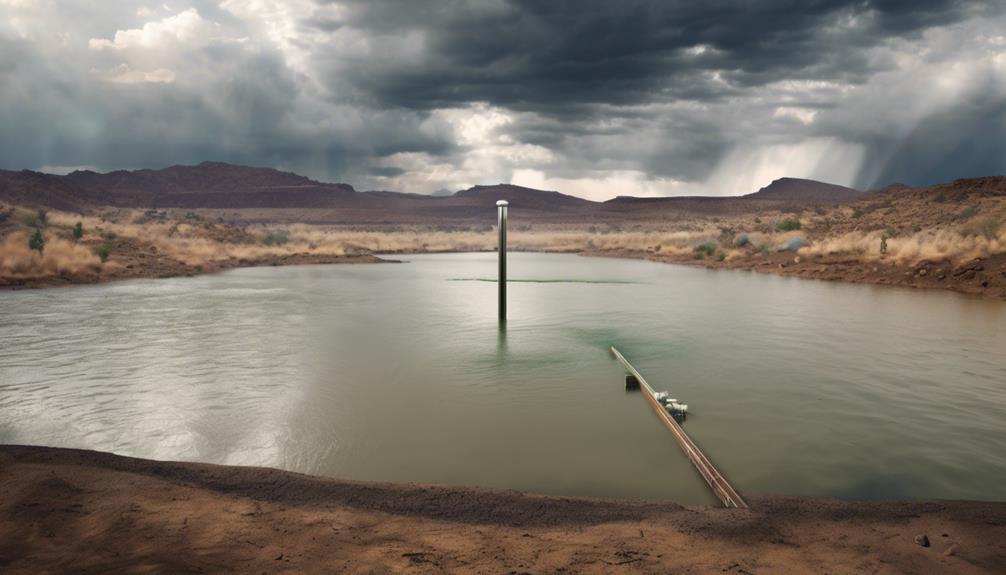As you gaze out over the serene waters of Lake Palestine, you may wonder about the current water level and its significance. Understanding the fluctuations in the lake's water level is crucial for various recreational activities and the well-being of the surrounding communities. Factors influencing this essential aspect are multifaceted and dynamic, impacting fishing, boating, and even water supply considerations. Stay tuned to learn more about the intricate balance between nature and human intervention that shapes the water level of Lake Palestine.
Factors Affecting Water Level

Understanding the factors influencing the water level of Lake Palestine is essential for predicting fluctuations and managing its resources effectively. One significant factor that affects the water level is precipitation. Rainfall patterns directly impact the lake's water level, with heavy rains leading to rises and droughts causing levels to drop.
Additionally, the inflow from tributaries plays an important role. Tributaries like the Neches River contribute water to the lake, affecting its overall volume. Human activities, such as water usage for irrigation or municipal supply, also influence the water level. Increased demand during dry seasons can lead to lower water levels.
Moreover, evaporation due to high temperatures in the region can cause water levels to decrease gradually over time. By monitoring these factors closely, authorities can better anticipate changes in the water level of Lake Palestine and implement necessary measures to ensure sustainable management of this essential resource.
Impact on Recreation
The water level of Lake Palestine directly impacts recreational activities enjoyed by visitors and locals alike. When the water level is high, it provides opportunities for activities like boating, jet skiing, and swimming. High water levels also make fishing more accessible from the shore or a boat.
On the other hand, during periods of low water levels, some boat ramps may be unusable, limiting the ability to launch larger watercraft. Low water levels can also expose hazards such as rocks or tree stumps that pose risks to boaters and swimmers.
Additionally, the shoreline of the lake changes with fluctuating water levels, impacting activities like picnicking and camping. Some areas may become submerged underwater, while new beach areas may emerge during times of high water levels.
It's crucial for visitors to stay informed about the current water levels to plan their recreational activities accordingly and ensure a safe and enjoyable experience at Lake Palestine.
Importance for Fishing

For fishing enthusiasts, the water level of Lake Palestine plays a significant role in determining the success and experience of their fishing trips. When the water level is high, it provides more habitat for fish to thrive, leading to increased fishing opportunities. High water levels often result in fish being closer to the shore, making them more accessible to anglers.
Additionally, submerged structures like trees and brush become prime spots for fish to congregate, improving the chances of a successful catch.
Conversely, during low water levels, fishing can become more challenging. Fish may move to deeper areas or become more scattered, requiring anglers to adjust their techniques and locations. Low water levels can also expose hazards such as rocks or stumps that may damage boats or fishing equipment.
As a result, staying informed about the water level of Lake Palestine is essential for planning successful fishing outings and adapting strategies based on the current conditions.
Water Supply Concerns
Amidst considerations of the Lake Palestine water level for fishing purposes, a growing concern revolves around the water supply sustainability and management for various stakeholders.
As you enjoy the recreational activities offered by the lake, it's important to acknowledge the delicate balance needed to guarantee a reliable water supply for the surrounding communities, industries, and wildlife.
The increasing demand for water poses a significant challenge, especially during dry seasons when the lake's water levels may decrease. Stakeholders must collaborate to implement effective water management strategies to address this concern.
This includes promoting responsible water usage, exploring alternative water sources, and investing in infrastructure to enhance water conservation and distribution.
Community Resilience

In times of adversity, fostering community resilience around Lake Palestine becomes crucial for ensuring sustainability and preparedness. Building strong bonds within the community is essential for weathering challenges like fluctuating water levels and environmental uncertainties.
By coming together, sharing resources, and supporting one another, the community can better adapt to changing conditions and mitigate potential risks.
During times of crisis, such as droughts or floods, a resilient community around Lake Palestine can mobilize quickly to address urgent needs, provide assistance to those affected, and implement effective emergency response plans.
Establishing communication channels, organizing community events, and creating support networks are key components of enhancing resilience and promoting unity among residents.
Furthermore, investing in education and training programs focused on disaster preparedness and sustainable practices can empower individuals to take proactive measures in safeguarding their community and natural resources.
Conclusion
Overall, monitoring the water level of Lake Palestine is essential for ensuring a balance between recreational activities, fishing opportunities, and sustainable water supply for surrounding communities.
By understanding the factors that influence water levels, stakeholders can make informed decisions to maintain the health and resilience of the lake ecosystem.
Stay informed and stay engaged to support the long-term sustainability of Lake Palestine.